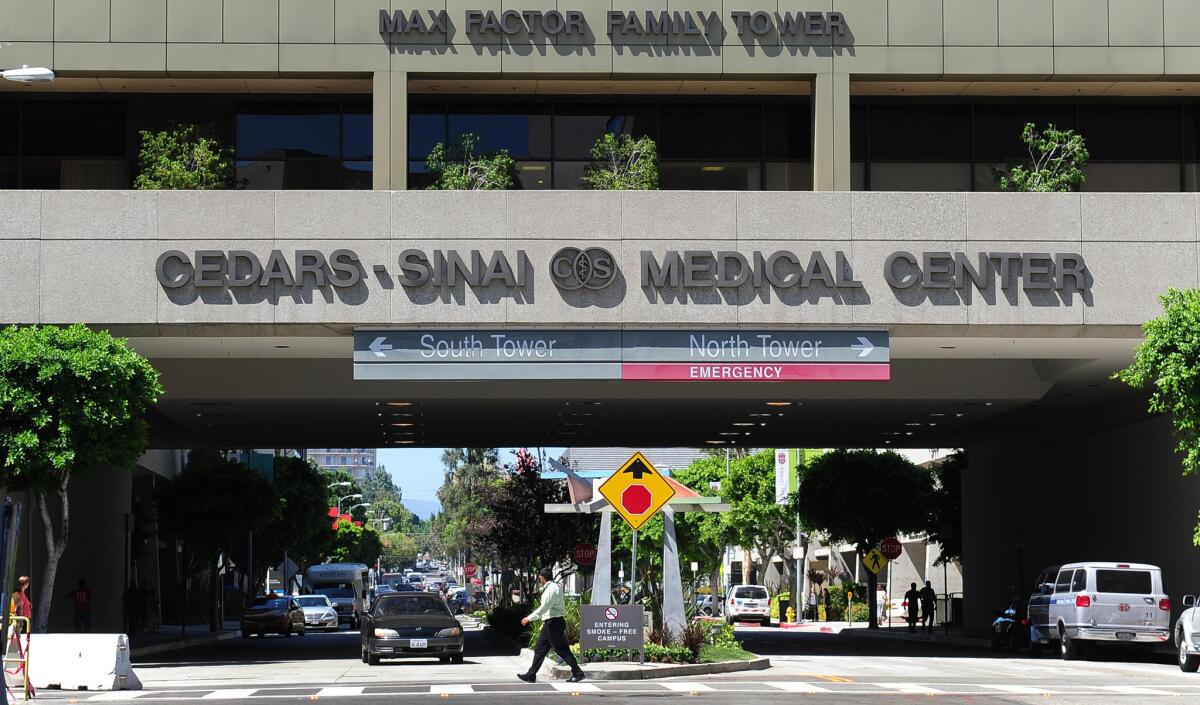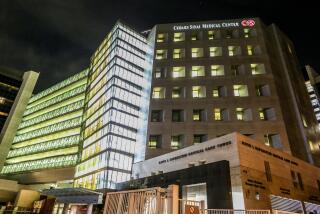Superbug outbreak extends to Cedars-Sinai hospital, linked to scope

In the latest superbug outbreak, Cedars-Sinai Medical Center discovered that four patients were infected with deadly bacteria from a contaminated medical scope, and 67 other people may have been exposed.
The Los Angeles hospital said Wednesday that it began investigating the possibility of patient infections after a similar outbreak at UCLA’s Ronald Reagan Medical Center that sickened seven patients, including two who died.
The widening problem is certain to ratchet up the pressure on the Food and Drug Administration, already under fire for ignoring warnings about these medical instruments.
Device makers, led by Japanese electronics giant Olympus Corp., face similar scrutiny for designing scopes that are difficult to clean of dangerous germs.
Federal lawmakers, consumer advocates and patients’ families have criticized both the regulators and manufacturers for failing to act sooner. The report by Cedars raises the prospect of many more disclosures, experts said, as other hospitals scour patients’ medical records and the scopes themselves looking for evidence linking infections to the devices.
“It’s highly likely many hospitals around the country have had outbreaks, and they haven’t been able to connect the dots until this problem was disclosed at UCLA,” said Lisa McGiffert, director of the Safe Patient Project at Consumers Union.
“It’s just a little late — especially for those who got infections and maybe died as a consequence,” she said.
Cedars-Sinai said one of the four infected patients died, but for reasons unrelated to carbapenem-resistant Enterobacteriaceae, or CRE. The other three patients have been discharged from the hospital, a spokesman said.
The superbug CRE is highly resistant to antibiotics and can kill up to 50% of infected patients.
In these cases, the bacteria can be transmitted during a procedure known as endoscopic retrograde cholangiopancreatography, or ERCP.
Nationally, about half a million patients a year undergo ERCP, in which a fiber-optic scope is threaded down the person’s throat to diagnose and treat problems in the digestive tract such as gallstones, cancers and blockages in the bile duct. These instruments are not the same type used in more routine endoscopies and colonoscopies.
Patients at Cedars-Sinai may have been exposed to the superbug from one Olympus duodenoscope in use from August 2014 to mid-February, according to the hospital. That’s the same model implicated in outbreaks at UCLA and Virginia Mason Medical Center in Seattle.
In a startling admission this week, the FDA acknowledged that the Olympus scope under scrutiny has been on the market since 2010 without the necessary government approval.
Regulators said they decided not to pull the device from the market because the scope is so widely used by doctors and hospitals and they didn’t want to trigger a product shortage.
As for the Cedars incident, an FDA spokeswoman said the agency will be working with the hospital, local health officials and the Centers for Disease Control and Prevention “to learn more about these infections, including the cleaning, disinfection and reprocessing steps in use.”
A spokesman for Olympus said the company didn’t believe further regulatory approval was necessary for the 2010 redesign of its TJF-Q180V duodenoscope. At the FDA’s request, the company subsequently filed for approval, which is pending.
Some medical experts and health officials have attributed these outbreaks to the intricate design of these scopes and how it impedes effective cleaning.
A day after the UCLA outbreak was reported by The Times on Feb. 18, the FDA warned hospitals and doctors about the infection risk from these devices. It said that following manufacturers’ cleaning instructions does not ensure that the scopes are free of bacteria, which can become trapped in tiny crevices near the tip of the devices.
Cedars emphasized Wednesday that it had meticulously followed the manufacturer’s instructions.
L.A. County health officials said they found no breaches in the cleaning protocol at Cedars. County officials also are recommending that all hospitals in the county perform a “retrospective review” of ERCP procedures to look for infections.
Before the developments at Cedars, Rep. Ted Lieu (D-Los Angeles) and Rep. Peter Roskam (R-Illinois) sent a letter to the FDA on Wednesday asking what steps the agency is taking on redesign or device cleaning to limit further infections.
They also want to know when the FDA first learned that the scope design could lead to infection.
Lieu said he pressed his concerns in a meeting Wednesday with Dr. Stephen Ostroff, the FDA’s chief scientist. Ostroff is slated to take over as acting FDA commissioner when Dr. Margaret Hamburg leaves at the end of March.
“I believe the new revelations at Cedars show that this problem is larger than people may have believed,” Lieu said. “Having met with the incoming commissioner, I am optimistic he is very focused on this issue and wants to solve it.”
FDA officials have defended their response, saying it took time to investigate the source of the infections and what could be done to reduce the risks.
Last month, the agency said it was aware of 135 possible patient infections from January 2013 to December 2014 linked to duodenoscopes.
Olympus spokesman Mark Miller noted that “while any complication affecting a patient’s health is a serious matter, the reported incidence of infections is extremely low” compared with the 500,000 ERCP procedures performed annually.
Cedars launched a review of its scopes and patient records after the UCLA incident became public. The hospital said its infection-control experts used molecular analysis to identify the unique “fingerprint” of bacteria among patients who received ERCP.
To prevent further infections, the hospital took the tainted scope out of service and adopted additional safety measures, including enhanced monitoring of scopes before and after procedures.
Cedars is offering patients who were possibly exposed a free home testing kit.
McGiffert, a consumer advocate, said the intense scrutiny comes too late for some patients.
“It’s really horrific to know so many people underwent these procedures when they could have known the danger beforehand,” she said. “They went in trusting the system, and the system broke down.”
Let us know if you have been affected by the hospital outbreaks
Twitter: @chadterhune
More to Read
Inside the business of entertainment
The Wide Shot brings you news, analysis and insights on everything from streaming wars to production — and what it all means for the future.
You may occasionally receive promotional content from the Los Angeles Times.











